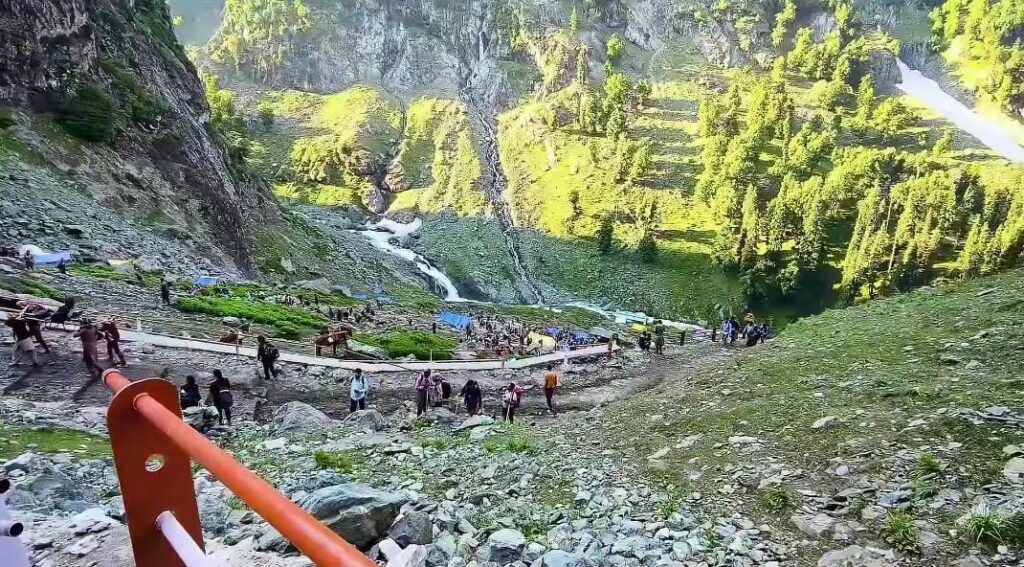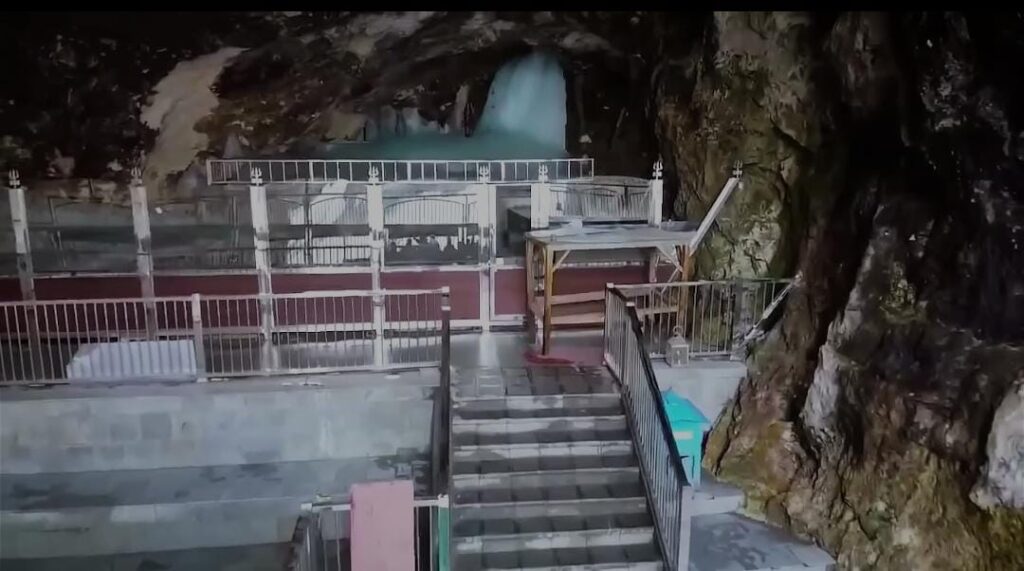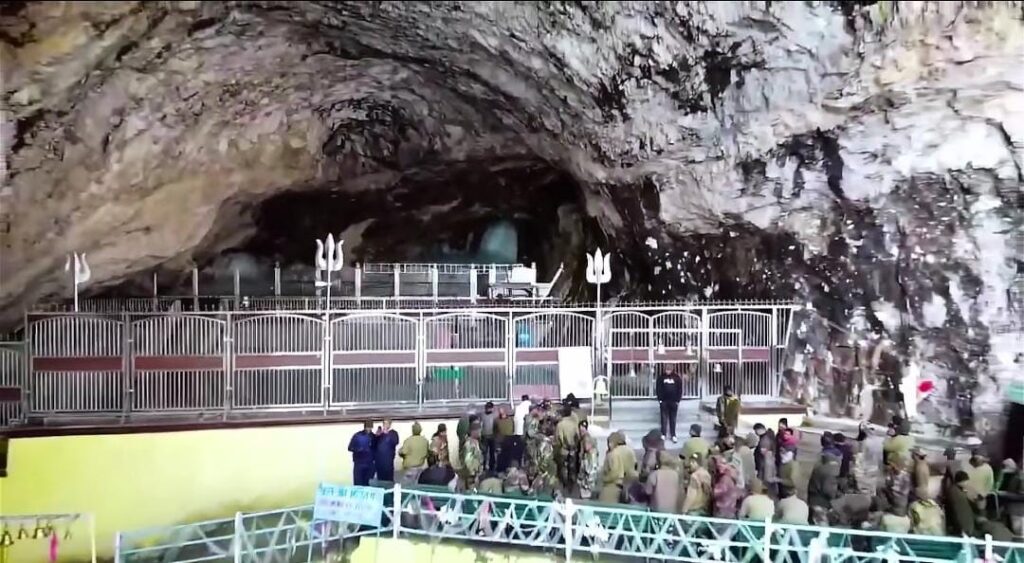


The Shri Amarnath Yatra Shrine
The Shri Amarnath Yatra Shrine is a Hindu pilgrimage site located in the Himalayas of Jammu and Kashmir. It is one of the holiest Hindu shrines, dedicated to Lord Shiva. The shrine is located in a cave at an altitude of 3,888 meters (12,756 feet). The cave is surrounded by glaciers and snowy mountains, and is covered with snow for most of the year.
The Amarnath Yatra is a challenging pilgrimage, but it is also a very rewarding one. Pilgrims trek to the cave to see the naturally formed ice lingam, which is said to represent Lord Shiva. The ice lingam grows bigger and smaller as the moon changes, and is at its largest on Shravan Purnima, the full moon day in the Hindu month of Shravan (July-August).
The Amarnath Yatra is typically undertaken during the summer months, when the weather is more favorable. However, the pilgrimage can be dangerous, as the weather can change quickly and the terrain is rugged. Pilgrims are advised to be in good physical condition before undertaking the Yatra, and to follow all safety precautions.
The Amarnath Yatra is a major pilgrimage event in India, and attracts hundreds of thousands of pilgrims each year. The pilgrimage is organized by the Shri Amarnathji Shrine Board (SASB), which provides various facilities and services to pilgrims along the way.
How to get to the Amarnath Yatra Shrine
The Amarnath Yatra Shrine can be reached by two routes: Pahalgam and Baltal. The Pahalgam route is the longer and more traditional route, and takes about 4-5 days to complete. The Baltal route is shorter and easier, and takes about 2-3 days to complete.
Pilgrims can register for the Amarnath Yatra online or at designated registration centers. After registering, pilgrims will receive a Yatra permit, which is required to travel to the shrine.
The history of the Amarnath Yatra Shrine
The history of the Amarnath Yatra Shrine can be traced back to thousands of years. According to Hindu mythology, the shrine is the place where Lord Shiva revealed the secret of life and immortality to his wife, Goddess Parvati.
The first written mention of the Amarnath Yatra Shrine is found in the Rajatarangini, a chronicle of Kashmir written by Kalhana in the 12th century AD. The Rajatarangini mentions that the shrine was visited by pilgrims from all over India, even in the 12th century.
The Amarnath Yatra Shrine became even more popular in the 19th century, when a Muslim shepherd named Buta Malik discovered the cave. Buta Malik is said to have been given a bag of coal by a saint, which turned into gold coins when he opened it at home. Buta Malik used the gold coins to build a temple at the entrance to the cave.
The Amarnath Yatra Shrine continued to be a popular pilgrimage site throughout the British colonial period. In the 20th century, the shrine was visited by many prominent Indian leaders, including Mahatma Gandhi and Jawaharlal Nehru.
The Amarnath Yatra Shrine is now one of the most popular pilgrimage sites in India. Millions of pilgrims visit the shrine each year, during the summer months of July and August. The pilgrimage is a challenging one, but it is also a very rewarding one. Pilgrims trek to the cave to see the naturally formed ice lingam, which is said to represent Lord Shiva. The pilgrimage is also seen as a way to cleanse one’s sins and achieve moksha (liberation).
The Amarnath Yatra Shrine is a significant religious site for Hindus, and it is a place where pilgrims can come to experience the beauty of nature, the power of spirituality, and the unity of their faith.
Significance of the Amarnath Yatra Shrine
The Amarnath Yatra Shrine is one of the holiest Hindu shrines, and is considered to be a place of great spiritual significance. The ice lingam in the cave is said to represent Lord Shiva, and is worshipped by pilgrims from all over India. The pilgrimage is also said to be a way to cleanse one’s sins and achieve moksha (liberation).
Home of Lord Shiva: People believe that the Amarnath Cave is where Lord Shiva, a powerful god in Hinduism, lives. Inside the cave, there is a special ice formation that looks like Lord Shiva, and it’s considered a sign of the god’s presence.
Yearly Journey: Every year, many people go on a journey to this cave. In 2023, over 4.5 lakh pilgrims visited the cave shrine, the highest number in recent years. They do this to connect with Lord Shiva and ask for his blessings. This journey usually happens during the summer months, and it’s quite tough because the route is challenging.
Religious Belief: For Hindus, visiting this cave is a very spiritual and religious experience. They think that by going on this tough journey and seeing the ice formation, their sins will be forgiven, and they’ll receive Lord Shiva’s blessings for a better life.
Natural Wonder: The ice formation inside the cave is thought to be something special because it changes in size with the moon’s phases. This is seen as a miracle of nature and a symbol of Lord Shiva’s power.
Cultural Importance: This yearly journey has been a part of Indian culture for a long time. It’s not just a religious thing but also a tradition that’s important for the people in this region.
Boosting the Region: Besides its religious meaning, the journey also helps the local economy. It brings in tourists who spend money on local businesses and creates jobs for the people who live there.
So, in simple words, the Amarnath Yatra Shrine is a very special place for Hindus. It’s where they go to pray to Lord Shiva, and it’s also a place of wonder in nature. This journey has a deep cultural and economic impact on the region as well.
20 Tips for amarnath yatra Shrine
The Amarnath Yatra is a significant pilgrimage that requires careful planning and preparation due to its challenging terrain and varying weather conditions. Here are some essential tips to help you have a safe and fulfilling journey:
Physical Fitness: Ensure you are physically fit for the journey. Start regular exercise and walking well in advance to build stamina and endurance.
Medical Check-up: Before the journey, consult a doctor for a thorough medical check-up to ensure you are in good health, especially if you have any pre-existing medical conditions.
Acclimatization: Before you start your journey, spend a day or two at the base camp or a place that’s not too far away. This helps your body adjust to the high altitude and reduces the chances of feeling sick because of it.
Packing: Pack lightly but efficiently. Carry essential clothing, rain gear, warm layers, and a good quality backpack. Don’t forget to bring any prescribed medications and first aid supplies.
Footwear: Invest in comfortable and sturdy trekking boots with excellent grip. Ensure that your shoes are used and comfortable before your journey to avoid getting blisters and feeling uncomfortable.
Weather Preparedness: Be prepared for varying weather conditions, which can include cold nights and rain. Dress in layers and pack accordingly.
Permits and Registration: Ensure you have all the required permits and registrations before starting the journey. Check the latest regulations and deadlines.
Route Selection: There are multiple routes for the Amarnath Yatra, each with its own challenges. Pick a path that suits how fit you are and what you like.
Guided Tours: Consider joining a guided tour or group. They often provide logistical support, medical assistance, and experienced guides, making the journey smoother and safer.
Food and Water: Carry essential dry snacks, energy bars, and bottled water for the journey. Along the route, there are langars (community kitchens) and local vendors where you can have meals.
Altitude Awareness: Be aware of the effects of high altitude on your body. If you experience symptoms of altitude sickness like headaches, nausea, or dizziness, descend to lower altitudes immediately.
Hydration: Stay well hydrated throughout the journey. Dehydration can worsen altitude sickness.
Emergency Contacts: Carry a list of emergency contact numbers, including local authorities and medical services, in case you need assistance.
Respect the Environment: Be environmentally responsible. Do not litter and respect the natural beauty of the region.
Respect Local Culture: The Amarnath Yatra is a spiritual journey deeply rooted in Hinduism. Respect local customs, traditions, and religious sentiments.
Patience and Determination: Be patient and mentally prepared for the challenges you may face along the way. The journey can be physically demanding and unpredictable.
Travel Insurance**: Consider getting travel insurance that covers medical emergencies and trip cancellations.
Plan for Accommodations: Book accommodations in advance, especially if you plan to stay in hotels or guesthouses along the way.
Follow Safety Guidelines: Pay attention to safety guidelines and instructions given by the authorities. Keep an eye on weather updates and any route changes.
Enjoy the Spiritual Experience: Remember that the Amarnath Yatra is not just a physical journey; it’s a spiritual one. Approach it with respect, being humble, and having a kind and open heart.
Conclusion
The Amarnath Yatra is a remarkable pilgrimage with deep spiritual and cultural significance in Hinduism. It takes pilgrims to the sacred Amarnath Cave, where a naturally formed ice lingam symbolizes Lord Shiva, one of the principal deities in Hindu mythology. The journey is both physically demanding and spiritually enriching, attracting devotees from all walks of life.
Over the years, the Amarnath Yatra has evolved from a relatively obscure religious practice to a well organized annual pilgrimage, thanks to government involvement and improvements in infrastructure. It has become a symbol of faith, endurance, and devotion, drawing hundreds of thousands of pilgrims each year.
While the journey presents challenges such as harsh terrain, changing weather, and high altitudes, it also offers a unique opportunity for self reflection and spiritual growth. Pilgrims undertake this arduous trek in the hope of finding inner peace, seeking blessings from Lord Shiva, and experiencing a profound connection with their faith.
The Amarnath Yatra is not just a physical expedition, it is a spiritual quest that brings people together, transcending boundaries and backgrounds. It is a testament to the enduring power of faith and the human spirit, as devotees, regardless of their hardships, continue to undertake this journey to connect with the divine. In conclusion, the Amarnath Yatra is a testament to the enduring power of faith, a celebration of cultural and spiritual heritage, and a journey that leaves a lasting impact In the hearts and minds of those who go on this journey.
Discover the Magic of Kashmir’s Natural Beauty in Our New Blog – An Adventure You Can’t Miss! Gulmarg , Dal Lake , Pahalgam , Tulip Garden , Doodhpathri Kashmir





